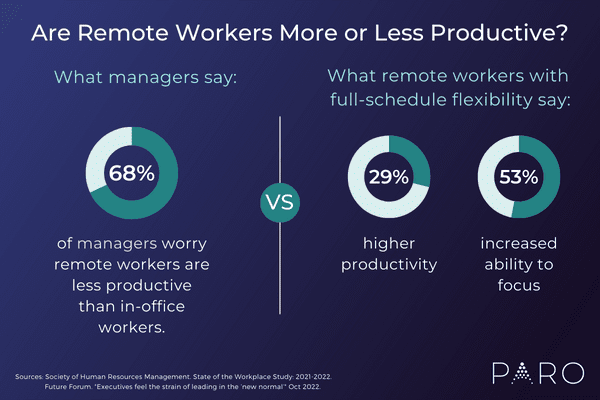The emergence of remote work has sparked debate among managers. While some companies embrace the idea of remote work, others argue that the challenges of managing remote employees far outweigh the benefits. Paro finance and accounting experts—and long-time remote professionals—Steve J. and Michele M., weigh in on the myths of remote work and examine how businesses can optimize remote collaboration and increase productivity.
Breaking Misconceptions: The Benefits of Remote Work
The recent telecommuting trend has brought many positive changes to the business world. Studies show that employees who work from home tend to have a higher degree of satisfaction and appreciation for their jobs, which leads to better overall retention rates. Additionally, going remote not only saves costs on office space and equipment, but it also allows access to a wider net of freelance talent around the world.
“The primary advantage of remote collaboration is being able to have a wider availability of talent that extends beyond just your immediate locality. It really broadens the perspective,” says Steve.
Despite these benefits, many organizations are still hesitant to embrace remote workplaces.
1. Myth: Remote Employees are Less Productive
According to a study conducted by the Society for Human Resource Management, 68% of managers worry that employees are not as productive when working from home as they are in the office.

However, research shows that this assumption doesn’t hold true. When surveyed, workers with schedule flexibility report 29% higher productivity and 53% increased ability to focus.
In fact, research using employee monitoring software confirmed a 5% increase in productivity among workers who switched to remote during the COVID-19 pandemic. With commutes, water cooler chats and frequent interruptions, in-office work can cut down on productivity.
“I’ve worked in the office as well, and I think if you’re in the office for eight hours, maybe you’re working three or four of those hours. It’s a lot of chit chat. It’s a lot of going to the kitchen for food. I’ve been based at home since 2017, and I work mostly hourly, so I can tell you that every hour that I allot, I’m working for that entire hour,” states Michele.
2. Myth: Remote Work Isn’t Good for Company Culture
A number of executives and managers believe that working from home stifles team collaboration and meaningful professional connections. In reality, remote work has been found to improve company culture by fostering greater trust, communication and flexibility. According to a study by Stanford University, remote workers tend to be happier, less stressed and less likely to quit their jobs than those who work in-office. These positive emotions feed into a healthy company culture and contribute to more effective remote team collaboration overall.
5 Tips to Overcome the Challenges of Managing Remote Employees
It’s common for managers to experience productivity and communication issues when first dealing with remote teams. According to Steve and Michele, there are certain steps businesses can take to overcome the challenges of managing remote employees, including freelance hires. Here’s what they recommend for improving remote collaboration:
1. Clarify the real problem first. (It may be your process.)
Your aversion to remote workspaces may be the symptom of a deeper issue within your operations. Often, inefficient manual or paper processes are keeping your workers in-office when those same tasks can be easily digitized. Steve and Michele recommend seeking out secure apps to digitize and automate processes that can be performed remotely. These may be banking apps, video presentation apps or something specific to your industry.
2. Set clear expectations during the hiring process.
Throughout the onboarding process, businesses should establish clear expectations for work schedules, deadlines and deliverables. Make sure all remote—especially freelance— team members understand their roles and responsibilities. This can also be established in a scope of work (SOW) for fractional talent.
“Some company cultures have more of a loose culture, some are more rigid. So when you first meet with someone, I think it’s important to set the expectation of, ‘We’re going to have weekly calls,’ or ‘I’ll just check in whenever,’’’ says Michele.
Consider setting weekly Friday check-ins with contract workers to keep everyone in the loop on progress, regardless of whether there is a deadline that week.
3. Establish clear communication channels.
In today’s digital age, there are countless ways to communicate virtually. It’s important for businesses to research and decide which channels and tools (i.e., project management software, video conferencing platforms and instant messaging apps) are best for helping their remote team stay connected in real time.
Having a strong organizational chart also helps teammates understand who the key players are when it comes time to communicate. It’s also important to keep teammates aware of the fractional talent involved in projects to keep remote collaboration tight.
4. Develop a data management plan.
“A lot of clients don’t understand that their software products allow an outside consulting, advisory or accounting user account,” states Steve. This makes providing access an issue when hiring remote freelance talent.
Ensure that all team members have the right level of access to data and resources. Use secure tools and protocols for file sharing and collaboration, and establish guidelines for protecting sensitive information.
“Having documents on personal drives is a huge issue, but I think it takes somebody at the business level to organize it. I’m a QuickBooks pro advisor, so within QuickBooks there is a function where you can share documents and upload statements. Everybody can see the same thing. It’s much more secure than sending it by email and it’s much easier to find,” says Michele.
Provide separate access, rather than admin, to remote workers where possible in order to track and weed out sources if issues arise. And keep documents in a shared drive rather than personal drives, so that you can still access important documents and maintain continuity in the event that a remote worker loses power or isn’t immediately available.
5. Build team unity.
Being part of a remote team can feel isolating, especially when working with contract employees. That’s why it’s critical to encourage team members to get to know one another and build relationships virtually. Use icebreakers, team-building activities and virtual social events to build rapport and create a sense of community.
While these strategies are critical for building strong remote collaboration, the most important task of all is hiring the right talent. At Paro, we match managers with efficient, trustworthy and quality remote talent to bring your finance and accounting operations to the next level. Improve your productivity with expert guiding insights and streamlined recruiting.






